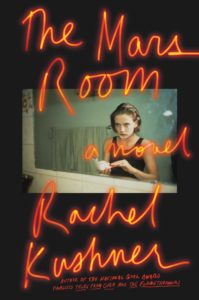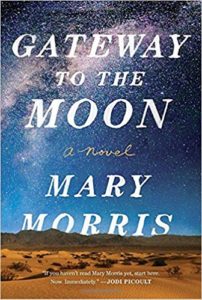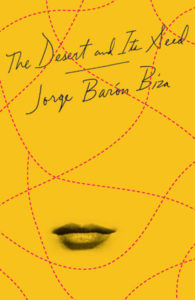
Mohsin Hamid’s Exit West racks up another prize—the Los Angeles Times fiction award. Among others honored at this past weekend’s Festival of the Book: Dan Egan’s The Death and Life of the Great Lakes (history), Joyce Carol Oates’ A Book of American Martyrs (mystery/thriller), Jenny Zhang’s Sour Heart (first fiction), and Patricia Smith’s Incendiary Art (poetry). Special awards went to Glory Edim for creating Well-Read Black Girl (innovator’s award) and John Rechy (lifetime achievement).
Novelist Alexander Chee’s first essay collection is “so good that several of its essays match the standards of Annie Dillard, Chee’s teacher;” “pages flash like mirrors in the sun, and the world of appearances is swallowed by light” in Joy Williams’s The Changeling, reissued forty years after its first publication; in Rachel Kushner’s third novel, “history and creation knot together like threads in a tapestry;” Anisfield-Wolf award winning Mary Morris is back with “a sweeping generational tale,” and a 1998 self-published novel by Argentine writer Jorge Baron Biza offers his tragic story in English for the first time.
Alexander Chee, How to Write an Autobiographical Novel
Novelist Chee’s artfully crafted essays delve into issues of identity—as played out in private life, culture, the arts, politics. He proves to be a consummate storyteller in any form.
“I studied with James Alan McPherson, who taught a class on reinventing myth,” Chee tells Tyler Malone (Los Angeles Times). “He said to us that it’s the artist’s responsibility to rewrite the myths of a culture for the next generation.”
“He traverses a breadth of topics, including reading tarot cards, catering parties for William F. Buckley, growing a rose garden, unearthing repressed memories of sexual abuse and even subletting an apartment in Gramercy Park where he met Chloë Sevigny in the elevator,” notes Crystal Hana Kim (Washington Post). “As Chee’s gaze turns inward, he beckons readers to experience his private moments with such clarity and honesty that we’re immediately brought into his consciousness. At the same time, he asks us to contemplate the largest questions about identity, sexuality, family, art and war. ”
“Chee is a very special artist; his writing is lyrical and accessible, whimsical and sad, often all at the same time,” writes Martha Anne Toll (NPR).
Anthony Domestico (Boston Globe) raves “How good is How to Write an Autobiographical Novel? It’s so good that I could fill my word count just with quotations…It’s so good that several of its essays match the standards of Annie Dillard, Chee’s teacher at Wesleyan and America’s greatest living essayist.”
Joy Williams, The Changeling
A fortieth-anniversary edition of Williams’ second novel, with an introduction by Karen Russell, introduces her unique voice to a new generation of readers.
“Joy Williams’s darkly comic stories and novels leap from the hazard of daily life to the mystery it arises from with the same agile precision as her prose,” writes Olivia Parkes (The Baffler). “To read Williams is to move dazed between the mundane and the profound: pages flash like mirrors in the sun, and the world of appearances is swallowed by light.”
“The Changeling is often called a work of magical realism, and it clearly draws on fairy tales,” writes Lincoln Michel (Bomb). “Transformations abound, both psychic and physical. At one point, Pearl watches a girl change into a deer: ‘Her tongue had then become a thick deer’s tongue and the hand she raised was a deer’s hoof, black and graceful, and her flanks were covered with tight, bright fur.’ Not much happens, and yet everything does. The book as a whole is as shifting and elusive as the sentences, where anything could be a drunken dream or a supernatural event. Forty years later, The Changeling remains a strange, shining object in Williams’s oeuvre.”
Tobias Carroll (Chicago Review of Books) writes, “Characters in The Changeling are trapped in myriad ways: in bodies they hate, in families they despise, in isolation that pushes them towards madness or illness. Much of the novel’s dizzying power comes from the juxtaposition of the familiar—a young woman who finds her own life caught up in that of the wealthy and powerful—with that which seems at odds with it: transformations, myths, and creation stories.”
Ellen Akins (Minneapolis Star-Tribune) notes, “In her contributor’s note in Best American Short Stories 1995, Williams wrote, ‘All art is about nothingness: our apprehension of it, our fear of it, its approach.’ In The Changeling she has filled up that nothingness with shimmering baubles from fairy tales and motherhood, madness and myth, and then, no doubt exhausted, thrown in the towel.”

Rachel Kushner, The Mars Room
Kushner’s third novel is set in a California women’s prison, and includes, among other things, a nuanced description of the dynamic between an inmate and a teacher.
“Like many in prison, Romy is desperate for outside help, needs money, and other things to survive, and, for her, anyone who is free has incredible resources that she doesn’t have,” Kushner tells The New Yorker’s Deborah Treisman.
“History winds around The Mars Room without ever breaking through the window,” writes Sasha Frere-Jones (Bookforum). “Gordon Hauser is a well-intentioned academic who ends up teaching at Stanville. It seems like an OK job, with a few chances to become useful. At first, Romy needs Gordon and his access to the outside world. When she finds out her son Jackson is in peril but that she’s lost her status as primary caregiver, Gordon is the only person she can ask to track him down. Just as Romy tries to enlist Gordon, he realizes that the prisoners often try to use him. He’s participating in his own submission.”
Lidija Haas (Harper’s) writes, “Kushner’s great gift is for the evocation of a scene, a time and place, and the atmosphere this book most frequently conjures—following prisoners around the administrative segregation cells and the electric-fenced yard, flashing back to their memories of court and skid row and the San Francisco strip club of the title, poking into the thoughts of men like Hauser, whose free-world lives seem almost equally stalled—is one of pervasive claustrophobia. The protagonist, Romy Hall, who yearns for the small son she left behind and is serving two consecutive life sentences without any realistic possibility of parole, sometimes recognizes that the prison is merely a horrifically exaggerated extension of the hamster wheel outside.”
“Kushner’s novels are the product of enormous research, but she rarely shows her work; history and creation knot together like threads in a tapestry,” writes Madeleine Schwartz (New York Review of Books). “Her voice is always authoritative, direct, and knowledgeable, so that even the fictions she creates have…certainty.”

Mary Morris, Gateway to the Moon
Morris’s new novel starts in a small town in New Mexico and reaches back into Spain at the time of Christopher Columbus’s voyages to the New World, a time when Jews were persecuted, went underground or fled.
“I never thought I’d be a writer who wrote about secret Jews, the Inquisition, and buried histories, but I have become passionate about it,” Morris tells Deborah Kalb.
Mackenzie Dawson (New York Post) calls Gateway to the Moon a “sweeping generational tale that stretches from the Spanish Inquisition to modern-day New Mexico. beginning with Luis de Torres, a Spanish Jew who accompanies Columbus as his interpreter. ”
“The story glides effortlessly between viewpoints and vibrant settings ranging from Lisbon to Tangiers, the Caribbean, and Mexico City,” notes Booklist‘s starred review. “With prose as clear as the star-strewn night sky, Morris’ novel explores people’s hidden connections.”
The Publishers’ Weekly review notes, “Morris’s richly detailed story explores the unlikely ways tradition can live on in the face of attempted annihilation.”

Jorge Baron Biza, The Desert and Its Seed, translated from the Spanish by Camilo Ramirez
The first English translation of an autobiographical novel self-published in Argentina in 1998 gives clues to its developing a cult following throughout the Spanish-speaking world.
Will Noah (4Columns) sets the stage: “Jorge Barón Biza committed suicide in 2001, twenty-three years after his mother, the Argentine politician Clotilde Sabattini, did the same, and thirty-seven years after his father, the writer and political agitator Raúl Barón Biza, flung a glass of acid in Sabattini’s face then shot himself. These facts loom large over the younger Barón Biza’s lone novel, first published in 1998 and now appearing in English translation after building a cult reputation in Argentina and beyond.”
“The Desert and Its Seed opens in the aftermath of a terrible event: the narrator, Mario, has just witnessed his father, Aron, throw acid in the face of his mother, Eligia—the culmination of a dysfunctional, abusive relationship that lasted for decades,” writes Tobias Carroll (Words Without Borders). “As Eligia seeks treatment for her wounds, Mario tends to her, while also drinking heavily and struggling with his father’s legacy of toxic masculinity. The resulting work is an emotionally (and physically) harrowing account of isolation, violence, and hypocrisy.”
The Publishers Weekly reviewer notes, “Both sides of Mario’s double life serve as a way for him to probe the gestalt of the female body, in which he sees by turns deceitful shape-shifting and the divine grace of regeneration. Men’s power to force that regeneration, be it through violence or surgery, is the source of Mario’s mingled desire and shame.”

